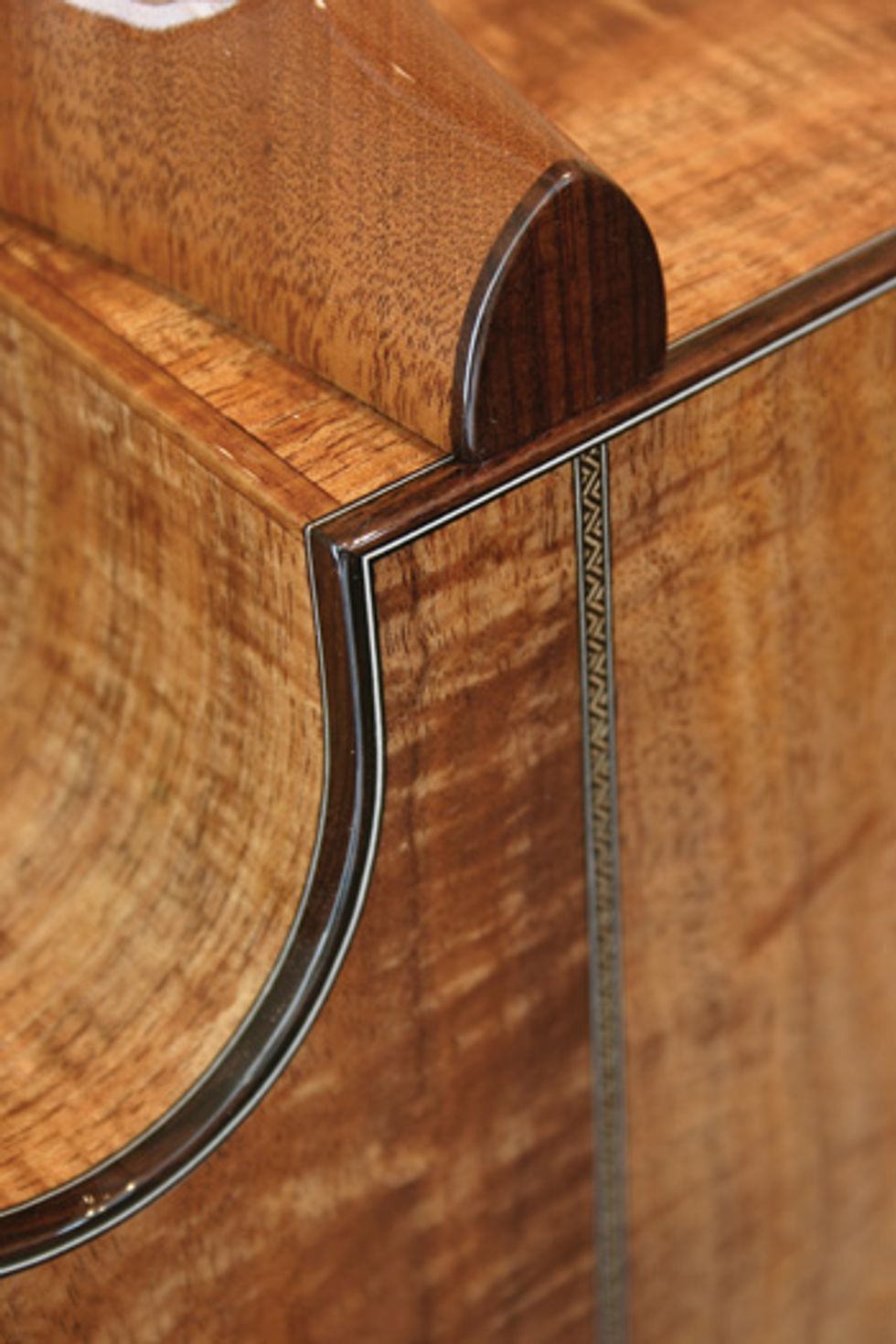
This guitar’s Indian rosewood binding contrasts nicely against its Australian-blackwood back and sides.
In the first two parts of this series, we covered the basics on how to get started ordering a custom guitar, as well as some of the construction details you’ll be deciding on in the process. This month, let’s talk about some of the cosmetic aspects you’ll need to determine for your custom instrument.
Bindings
As with most parts of the custom-guitar
design process, we could go on for days
about binding possibilities, but I will try
and stick to the ones that we get into most
often. While we do a lot of wood bindings
because we prefer that look, we also do
plastic bindings as well. One thing to keep
in mind is that you shouldn’t expect to hear
a difference in the tone between the two
options: The choice is strictly cosmetic.
Wood Bindings
The options here are almost endless, but we
usually do our wood bindings with maple,
Indian rosewood, or koa. We’ll also use
cocobolo or ebony occasionally. The biggest
decision here comes down to how the color
and figure of the bindings contrast with
the color and figure of the back and side
woods. You may like a lot of contrast, such
as maple against rosewood, or you may like
the almost-unbound look of rosewood on
rosewood, with maybe just a set of black/white/black lines in-between.
You can find plenty of images on the internet to give you an idea of the different options for your guitar, so be sure to research as many as possible before deciding. Do be aware, however, that wood colors and grains vary, so you may not get exactly the same color and figure in your wood bindings that you saw in another example. As with all details, trust the input of your guitar builder on these things. We’ve done it many times before, so we know what works, and what doesn’t.
Plastic Bindings
Often, and mostly for the sake of tradition,
we use various plastic bindings. These are
usually ivoroid, white plastic, black plastic, or
tortoise-colored plastic. If you are ordering a
tradition-based model, I would recommend
that you stick with whatever your grandpa’s
guitar had for binding. You might like the
idea of tortoise binding on your D-28-styled
guitar at first, but later on—especially if you ever want to sell it—you may end up wishing
that you had chosen traditional ivoroid
or white plastic instead.
Purfling Schemes
There are just as many purfling options
as there are binding options, but we usually
see one of just a few. Those include
black/white/black fiber lines, herringbone,
rope style, or abalone. Abalone top trim is
something that has gone a bit out of style,
but is still a real jaw-dropper when you
see it. It will move most instruments into
a showier context, and certainly also costs
quite a bit more. Herringbone is often a
good choice, even on an instrument that
you would normally not see herringbone. If
you add herringbone to a mahogany guitar,
for example, you can add flair to the look, without giving it a design scheme that’s a
bit too weird. It will look traditional, but
with a different touch.
Finishes
We do several top colors other than natural,
including a lot of sunbursts. And we
offer two basic sunbursts: our three-color
(aka standard) and two-color sunburst.
The two-color sunburst is reddish brown
on the outside edge, whereas our standard
burst is black on the outside edge. Every
builder has their own, and most will gladly
send you pictures. It’s worth noting that
sunbursts are not only notoriously difficult
to photograph—it’s very hard to do two
that are exactly alike. So allow your builder
some license here. I’ve been doing sunbursts
for 19 years now and I’ve hardly ever done
two that are exactly the same. When you
embrace that concept, a sunburst can be a
unique way to distinguish your guitar from
a similar style.
We also do aging toner top-finish once in a while. You can add just a bit of a yellowing agent with the first coat of the top’s finish to give it an antiqued look. This looks best when done on very traditional-designed guitar.
As for staining the back, sides, and neck, I do recommend that you stain mahogany, especially with the lighter-colored mahoganies that we use today. They can be very pale and sometimes an unattractive pinkish color when not stained. The exception here would be mahoganies that have quite a bit of ribbon figure. They often have a darker color than normal, and will display a striking luminescence when left unstained.
Remember that these rough guidelines are influenced by personal tastes, so get with your builder and flesh out your own ideas on these things. If you’re just the right amount creative while remaining open-minded and respectful of the opinions of those with experience, you will end up with a beautiful and unique instrument.
Next time, we’ll cover inlays and move on to pickup and set-up choices.
 Mark Dalton is a founding partner of Huss & Dalton
Guitar Company. When not building guitars, Mark and
his wife, Kimberly, tend to the draft horses and mules
that inhabit their farm in the Piedmont region of Virginia.
Mark Dalton is a founding partner of Huss & Dalton
Guitar Company. When not building guitars, Mark and
his wife, Kimberly, tend to the draft horses and mules
that inhabit their farm in the Piedmont region of Virginia.
















